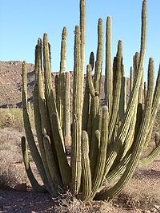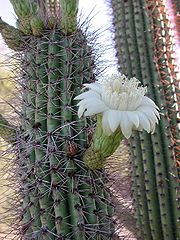
Organ Pipe Cactus
Encyclopedia
The Organ Pipe Cactus (Stenocereus thurberi) is a species of cactus
native to Mexico
and the United States
. The species is found in rocky desert. Two subspecies are recognized based on their distribution and height. The Organ Pipe Cactus National Monument
is named for the species.
It is locally known as pitahaya dulce, Spanish for "sweet pitahaya". Elsewhere, this refers to Hylocereus
fruit, which do not grow well in the Organ Pipe Cactus' arid
range.
 This cactus species has several narrow stems that rise vertically, growing from a single short trunk just above the ground level. These stems are about 6 inches (15 cm) thick and grow to a height of 16 feet (5 m), however it has been known to reach 23 to 26 feet (7 to 8 m). These stems rarely branch but rather grow annually from the tip of the last growth. The mature plant can reach a width of 12 feet (3.7 m). Each stem has 12 to 19 inch (.85 cm) high ribs that bear dark brown to black spines that turn gray as it matures. It takes 150 years to reach maturity. The older plants produce three-inch (8 cm) funnel-shaped white flowers annually which are open at night and close by the morning and have a purple or pink tint to them. These usually grow during April, May, and June. The organ pipe cactus is usually pollinated by bats. The plant also produces fruit about the size of a tennis ball. Beneath the fruit's spined exterior is red flesh that supposedly tastes like watermelon. This fruit has traditionally been harvested by the Seris, who call the plant ool oːɬ, and is used as a medicine.
This cactus species has several narrow stems that rise vertically, growing from a single short trunk just above the ground level. These stems are about 6 inches (15 cm) thick and grow to a height of 16 feet (5 m), however it has been known to reach 23 to 26 feet (7 to 8 m). These stems rarely branch but rather grow annually from the tip of the last growth. The mature plant can reach a width of 12 feet (3.7 m). Each stem has 12 to 19 inch (.85 cm) high ribs that bear dark brown to black spines that turn gray as it matures. It takes 150 years to reach maturity. The older plants produce three-inch (8 cm) funnel-shaped white flowers annually which are open at night and close by the morning and have a purple or pink tint to them. These usually grow during April, May, and June. The organ pipe cactus is usually pollinated by bats. The plant also produces fruit about the size of a tennis ball. Beneath the fruit's spined exterior is red flesh that supposedly tastes like watermelon. This fruit has traditionally been harvested by the Seris, who call the plant ool oːɬ, and is used as a medicine.
 This species is found mostly in Mexico
This species is found mostly in Mexico
, mainly in Sonora
and southern Baja California
. It is also known to the United States, but is much rarer, with the notable exception of Organ Pipe Cactus National Monument
. The plant is predominantly found on rocky hillsides up to 3000 feet (900 m) in elevation. It is sensitive to frost, so the species is rare in low desert areas, which can be more susceptible to frost. The plant is slow growing, and prefers well-drained soil
and full sun. However, when in the seedling stage, it requires shade, and will grow beneath a "nurse tree". It will need this for several years until it grows an adequate root system, which is mostly in the upper 10 cm of soil.
Cactus
A cactus is a member of the plant family Cactaceae. Their distinctive appearance is a result of adaptations to conserve water in dry and/or hot environments. In most species, the stem has evolved to become photosynthetic and succulent, while the leaves have evolved into spines...
native to Mexico
Mexico
The United Mexican States , commonly known as Mexico , is a federal constitutional republic in North America. It is bordered on the north by the United States; on the south and west by the Pacific Ocean; on the southeast by Guatemala, Belize, and the Caribbean Sea; and on the east by the Gulf of...
and the United States
United States
The United States of America is a federal constitutional republic comprising fifty states and a federal district...
. The species is found in rocky desert. Two subspecies are recognized based on their distribution and height. The Organ Pipe Cactus National Monument
Organ Pipe Cactus National Monument
Organ Pipe Cactus National Monument is a U.S. National Monument and UNESCO biosphere reserve located in extreme southern Arizona which shares a border with the Mexican state of Sonora. The park is the only place in the United States where the Organ Pipe Cactus grows wild...
is named for the species.
It is locally known as pitahaya dulce, Spanish for "sweet pitahaya". Elsewhere, this refers to Hylocereus
Hylocereus
Hylocereus is a genus of cacti, often referred to as nightblooming cactus . Several species have large edible fruits, which are known as pitaya or dragonfruits.-Taxonomy:...
fruit, which do not grow well in the Organ Pipe Cactus' arid
Arid
A region is said to be arid when it is characterized by a severe lack of available water, to the extent of hindering or even preventing the growth and development of plant and animal life...
range.
Description

Distribution

Mexico
The United Mexican States , commonly known as Mexico , is a federal constitutional republic in North America. It is bordered on the north by the United States; on the south and west by the Pacific Ocean; on the southeast by Guatemala, Belize, and the Caribbean Sea; and on the east by the Gulf of...
, mainly in Sonora
Sonora
Sonora officially Estado Libre y Soberano de Sonora is one of the 31 states which, with the Federal District, comprise the 32 Federal Entities of Mexico. It is divided into 72 municipalities; the capital city is Hermosillo....
and southern Baja California
Baja California Sur
Baja California Sur , is one of the 31 states which, with the Federal District, comprise the 32 Federal Entities of Mexico. Before becoming a state on October 8, 1974, the area was known as the South Territory of Baja California. It has an area of , or 3.57% of the land mass of Mexico and comprises...
. It is also known to the United States, but is much rarer, with the notable exception of Organ Pipe Cactus National Monument
Organ Pipe Cactus National Monument
Organ Pipe Cactus National Monument is a U.S. National Monument and UNESCO biosphere reserve located in extreme southern Arizona which shares a border with the Mexican state of Sonora. The park is the only place in the United States where the Organ Pipe Cactus grows wild...
. The plant is predominantly found on rocky hillsides up to 3000 feet (900 m) in elevation. It is sensitive to frost, so the species is rare in low desert areas, which can be more susceptible to frost. The plant is slow growing, and prefers well-drained soil
Soil
Soil is a natural body consisting of layers of mineral constituents of variable thicknesses, which differ from the parent materials in their morphological, physical, chemical, and mineralogical characteristics...
and full sun. However, when in the seedling stage, it requires shade, and will grow beneath a "nurse tree". It will need this for several years until it grows an adequate root system, which is mostly in the upper 10 cm of soil.
Subspecies
There are two recognized subspecies, the nominate, thurberi, is much larger and occurs in southern Arizona, mainland Mexico, and Northern Baja California. The other is littoralis, which is much smaller and usually grows to around 10 feet (3 m). It occurs only in southern Baja California.See also
- Organ Pipe Cactus National MonumentOrgan Pipe Cactus National MonumentOrgan Pipe Cactus National Monument is a U.S. National Monument and UNESCO biosphere reserve located in extreme southern Arizona which shares a border with the Mexican state of Sonora. The park is the only place in the United States where the Organ Pipe Cactus grows wild...

